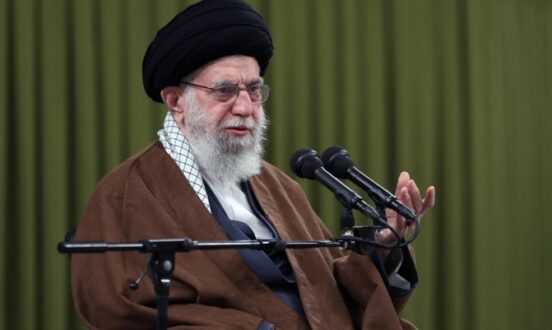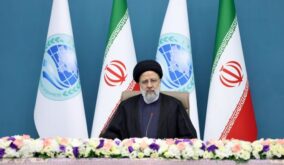RFL/RE – Senior Iranian intelligence and security officials met last week in the northeastern religious city of Mashhad to discuss a coordinated strategy to counter what state media described as “plots” by the country’s “enemies.”
The June 15 meeting, which was not reported by state media until a week later with no explanation, appeared to be intended to increase cooperation between the Intelligence Ministry and the intelligence branch of the powerful Islamic Revolutionary Guards Corps (IRGC).
Iranian Supreme Leader Ayatollah Ali Khamenei said in a message addressed to the meeting that “the lack of understanding” between the country’s intelligence bodies is “our weakness,” while calling for increased intelligence cooperation “at all levels.”
The message by Khamenei, who has ultimate power in the Islamic republic, was read by his chief of staff, Ayatollah Mohammad Mohammadi Golpayegani.
Other attendees included Intelligence Minister Esmail Khatib, the IRGC’s intelligence chief, General Mohammad Kazemi, IRGC commander Major General Hossein Salami, and the newly appointed secretary of the Supreme National Security Council, Rear Admiral Ali Akbar Ahmadian.
Power Struggle?
The meeting followed several months of antiestablishment protests, and highlights the Islamic republic’s concerns about instability and potential future protests.
It could also suggest a power struggle and rivalry between the Iran’s two main intelligence bodies, which in recent years have failed to prevent the November 2020 assassination near Tehran of a top nuclear scientist, cyberattacks targeting state institutions, and acts of sabotage against the country’s nuclear and military facilities.
Saeid Golkar, a senior fellow on Iran policy at the Chicago Council on Global Affairs, told RFE/RL that competition between the two groups has led to “the mishandling of some situations, potentially leading to ineffective intelligence operations and conflicts of interest.”

“The meeting shows Khamenei’s frustration with the competition between these two forces,” Golkar said, adding that the presence of the supreme leader’s chief of staff and the head of his military office at the meeting was “significant.”
The IRGC’s intelligence branch was created in 2009 shortly after the disputed presidential election that year triggered mass protests and a brutal state crackdown. The feared branch has expanded its activities in recent years, arresting scores of activists, conservationists, and alleged spies as well as foreigners and dual nationals.
Preventing ‘Plots And Seditions’
The IRGC’s intelligence branch was created in 2009 shortly after the disputed presidential election that year triggered mass protests and a brutal state crackdown. The feared branch has expanded its activities in recent years, arresting scores of activists, conservationists, and alleged spies as well as foreigners and dual nationals.
Speaking at the meeting, the head of the Supreme Leader’s military office, General Mohammad Shirazi, said intelligence bodies should work together to prevent “plots and seditions” through intelligence work, preparation, and timely action.

IRGC commander Salami referred to the Intelligence Ministry and the IRGC’s intelligence body as “the two eyes” of the establishment that should work to provide “a single picture” and prevent what he described as “political astigmatism.”
Antiestablishment sentiments have been on the rise in Iran amid a deteriorating economy that has led to rising poverty. The protests have led to increased state repression and the crackdowns that have left about 500 dead, including children, according to rights groups.
Earlier this week, IRGC intelligence chief Kazemi alleged that 20 countries were involved in the recent nationwide antiestablishment protests sparked by the September death in custody of 22-year-old Mahsa Amini following her arrest by the morality police in Tehran.
In a June 19 interview with Khamenei’s website, Kazemi, who was appointed as IRGC intelligence chief last year amid a major shakeup, claimed that the United States, the United Kingdom, France, Germany, Canada, Belgium, Iceland, Italy, and Iran’s regional rival, Saudi Arabia, and archfoe Israel were among the countries involved in fomenting the protests.SEE ALSO:In Major Security Shake-Up, Iran Replaces IRGC Intelligence Chief
Speaking at the June 16 meeting, Kazemi called for increased cooperation between intelligence bodies and said there should be joint action and the formation of joint operational bases.
For his part, Intelligence Minister Khatib said his ministry and the IRGC’s intelligence branch must develop joint strategies and improve information-sharing to counter what he called “coherent and extensive” planning by “the enemies” against the Islamic republic.
Khatib said the intelligence meetings will continue to fulfill Khamenei’s demands for greater cooperation between the two intelligence bodies.
 Shabtabnews In this dark night, I have lost my way – Arise from a corner, oh you the star of guidance.
Shabtabnews In this dark night, I have lost my way – Arise from a corner, oh you the star of guidance.



